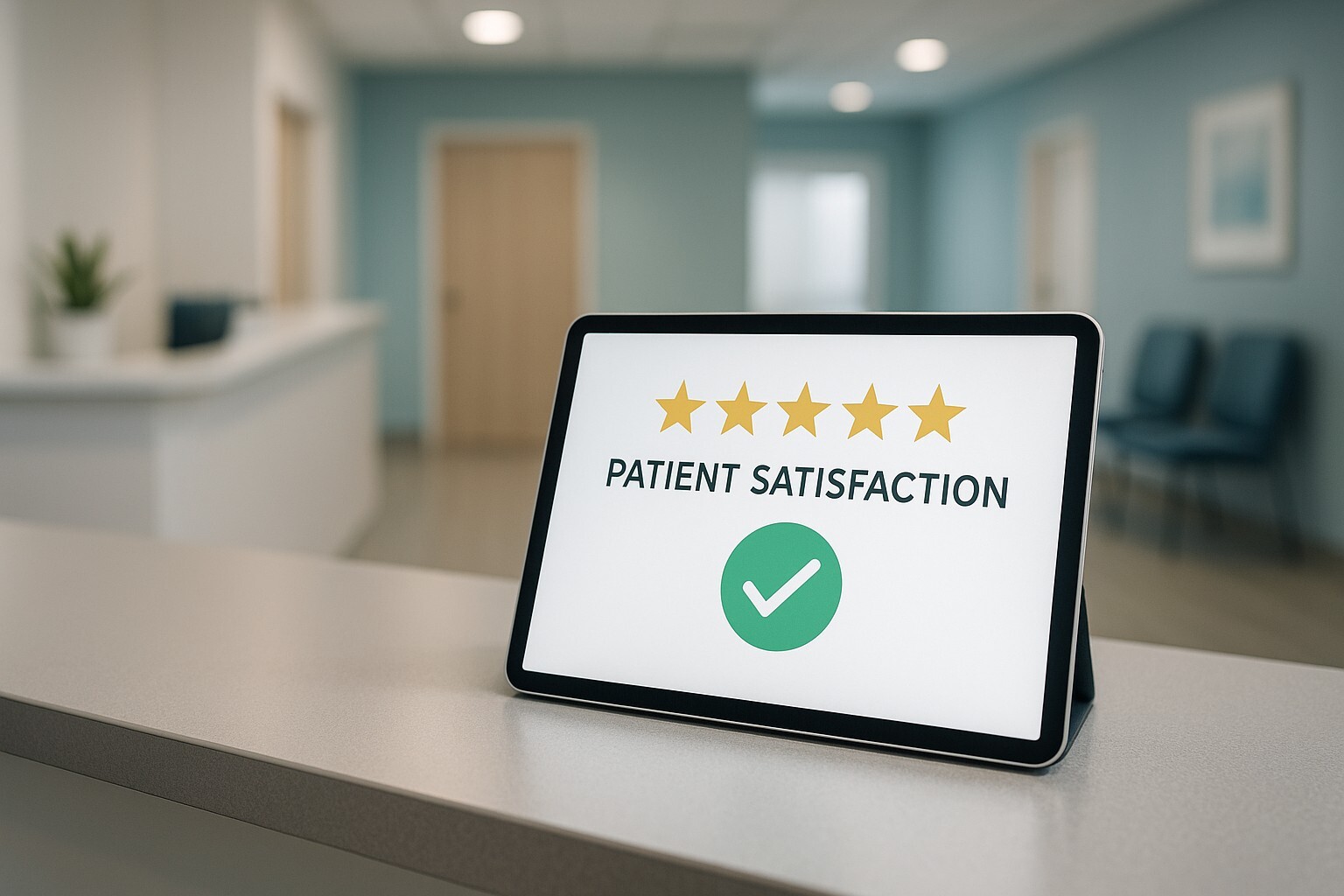55+ Patient Satisfaction Survey Questions, Templates and Strategies
A patient satisfaction survey is a critical tool that provides a direct line of communication between healthcare providers and the people they serve....
14 min read
Alvin Amoroso : 7/26/25 2:56 AM

A patient satisfaction survey is a structured questionnaire designed to capture patient feedback on their experiences with your healthcare services. By translating subjective feelings into measurable data, these surveys provide a clear roadmap for improving quality of care, boosting patient loyalty, and driving practice growth. This guide will walk you through every step of the process.
Why Your Practice Can't Afford to Ignore Patient Satisfaction
In today’s value-based healthcare landscape, the patient's voice is more powerful than ever. It's no longer enough to provide excellent clinical care; the entire patient experience, from the first phone call to the final bill, shapes their perception of your practice. A well-executed patient satisfaction survey is not a "nice-to-have"—it's a fundamental tool for survival and growth.
Research consistently shows the immense impact of patient perception. A satisfied patient is not just a returning customer; they are your most effective advocate. Studies show that 68% of satisfied patients recommend their healthcare providers to friends and family, directly fueling your practice's growth. Conversely, a single negative experience can erode trust and damage your reputation through word-of-mouth and online reviews.
Let's explore the critical reasons why implementing a robust survey strategy is essential.
The most important reason to learn how to create a patient satisfaction survey is to gain actionable insights that directly improve clinical and operational quality. You might believe your wait times are reasonable or your discharge instructions are clear, but surveys provide objective data to validate or challenge those assumptions. They help you pinpoint specific friction points in the patient journey—whether it's a communication gap with a clinician, a confusing billing statement, or a lack of cleanliness in the waiting room—that you might otherwise overlook. By systematically identifying and addressing these issues, you create a cycle of continuous quality improvement.
Acquiring a new patient is significantly more expensive than retaining an existing one. Patient loyalty is built on trust and feeling valued. When you proactively ask for feedback and, more importantly, act on it, you send a powerful message: "We care about your experience, and your opinion matters." This simple act fosters a stronger patient-provider relationship, making patients feel like partners in their own care. This emotional investment translates into higher retention rates, as patients are far less likely to switch providers when they feel heard and respected.
Patient satisfaction has a direct and measurable impact on your bottom line. Firstly, loyal, retained patients represent a stable, long-term revenue stream. Secondly, positive experiences generate powerful word-of-mouth marketing and glowing online reviews. With over 70% of patients consulting online reviews before choosing a new provider, a strong positive reputation is a magnet for new business. Furthermore, in many healthcare systems, reimbursement rates from insurers and government bodies like CMS are increasingly tied to patient satisfaction scores, such as those from the HCAHPS survey. Better scores can literally mean higher payments.
Patient feedback provides an invaluable, objective lens through which to evaluate staff performance. It can highlight which staff members—from front-desk receptionists to nurses and physicians—are excelling at patient communication and empathy. It can also identify areas where additional training may be needed. When handled constructively, this feedback should not be used as a punitive tool, but as a mechanism for professional development. Celebrating staff who receive positive feedback and providing targeted coaching for those who don't creates a more skilled, motivated, and patient-centric team. A Sermo poll revealed that 51% of physicians see this as a primary benefit of surveys.
A strong correlation exists between patient dissatisfaction and the likelihood of malpractice litigation. Many lawsuits stem not from poor clinical outcomes alone, but from perceived disrespect, poor communication, or feeling ignored. Patients who feel they have a positive, respectful relationship with their provider are less likely to pursue legal action, even when an outcome is not ideal. Moreover, conducting and reporting on patient satisfaction is often a requirement for accreditation and compliance with regulatory bodies. Systematically gathering this feedback demonstrates a commitment to quality and transparency, keeping your practice in good standing.
To transform subjective opinions into objective data, you need to use standardized metrics. These three acronyms—CSAT, NPS, and CES—are the global standards for measuring customer experience and are perfectly suited for healthcare.
The CSAT score is the most direct measure of satisfaction with a specific interaction or experience.

Developed by Fred Reichheld, the NPS is considered the gold standard for measuring overall patient loyalty.
CES measures how easy it was for a patient to get their needs met. In healthcare, reducing patient effort is a key driver of satisfaction.
Now, let's move from theory to practice. Properly learning how to create a patient satisfaction survey is a methodical process. Follow these steps to ensure you gather high-quality, actionable data.
Before you write a single question, you must answer the most important one: "What problem are we trying to solve?" or "What do we want to learn?" Your objectives will guide every other decision. Without clear goals, you risk creating a generic survey that yields vague, unactionable data.
Your goals should be SMART: Specific, Measurable, Achievable, Relevant, and Time-bound.
Examples of strong objectives:
The patient journey for someone staying overnight in a hospital (inpatient) is vastly different from that of someone visiting a clinic for a consultation (outpatient). Your survey must reflect this reality.
The quality of your data depends entirely on the quality of your questions. This is the most challenging component of learning how to create a patient satisfaction survey, but adhering to a few key principles will ensure your success:
Principles of Good Question Design:
The HCAHPS (Hospital Consumer Assessment of Healthcare Providers and Systems) survey is the national, standardized survey of hospital patients created by the Centers for Medicare & Medicaid Services (CMS) and the Agency for Healthcare Research and Quality (AHRQ). It is the benchmark for hospital satisfaction. While you may not need to run the full survey, its questions are a masterclass in design. You can find more information on the official HCAHPS website.
Key HCAHPS question domains to learn from:
Use these questions as a starting point. Mix and match rating scales, multiple-choice, and open-ended questions.
Questions About Access & Scheduling
Questions About the Facility 5. How would you rate the cleanliness and hygiene of our facility? (Scale: Excellent to Poor) 6. How would you rate the comfort of our waiting room? (Scale: Excellent to Poor) 7. How easy was it to find our practice/clinic? (Scale: Very Easy to Very Difficult)
Questions About Your Doctor/Clinician 8. How often did your doctor treat you with courtesy and respect? (Scale: Always, Usually, Sometimes, Never) 9. How often did your doctor listen carefully to you? (Scale: Always, Usually, Sometimes, Never) 10. How often did your doctor explain things in a way you could understand? (Scale: Always, Usually, Sometimes, Never) 11. How much confidence do you have in this provider? (Scale: Very High to Very Low) 12. Did you feel the doctor spent enough time with you? (Yes/No)
Questions About Nurses & Staff 13. How often did the nursing staff treat you with courtesy and respect? (Scale: Always, Usually, Sometimes, Never) 14. How would you rate the professionalism of our front-desk staff? (Scale: Excellent to Poor) 15. Were your questions and concerns addressed in a timely manner? (Yes/No)
Questions About the Overall Experience & Loyalty (NPS/CSAT) 16. Overall, how satisfied were you with your visit today? (5-Point CSAT Scale) 17. On a scale of 0-10, how likely are you to recommend our practice to friends and family? (0-10 NPS Scale) 18. Was there one person who went above and beyond for you during your visit? (Open-Ended) 19. What is the one thing we could do to improve your experience with us? (Open-Ended) 20. Please share any other comments or feedback you may have. (Open-Ended)
How you deliver the survey is just as important as the questions themselves. Use a multi-channel approach to reach patients where they are most comfortable.
Once the responses start rolling in, the real work begins. Your goal is to turn raw data into actionable intelligence.
Quantitative Analysis: This is the analysis of your numerical data (rating scales, multiple-choice).
Qualitative Analysis: This is the analysis of your open-ended comments. This is where you find the "why" behind your scores.
Collecting data without acting on it is worse than not collecting it at all. It tells your patients that you asked for their opinion but didn't care enough to do anything with it.
A one-size-fits-all survey is rarely effective. A sophisticated understanding of how to create a patient satisfaction survey involves tailoring your questions and approach to the unique patient journey in different healthcare environments. Here’s how to do it.
The practice of measuring patient satisfaction has evolved from informal comment cards to a sophisticated science powered by technology. Understanding this context helps in appreciating the tools available today.
Historically, feedback was passive and retrospective, often collected weeks after care via paper mailers. This led to low response rates and outdated data. The digital revolution, accelerated by the HCAHPS initiative, changed everything.
Today, technology enables real-time feedback. A patient can receive an SMS survey moments after leaving your clinic, providing an immediate, top-of-mind impression. This allows for rapid service recovery—if a patient reports a negative experience, you can be alerted instantly and have a manager follow up within hours, not weeks.
The Technology Stack for Patient Feedback:
Learning how to create a patient satisfaction survey is a critical first step, but it's only the beginning. The ultimate goal is to embed the patient’s voice into the very fabric of your organization—to build a truly patient-centric culture.
This happens when feedback is not seen as a score to be managed, but as a gift to be opened. It's a continuous conversation with the people you serve, providing a constant stream of opportunities to learn, adapt, and excel. By committing to the full process of how to create a patient satisfaction survey—from asking the right questions and listening carefully to the answers, to acting decisively on the insights—you transform your practice from a simple service provider into a trusted partner in your patients' health journeys. The result is not just better survey scores, but better care, stronger relationships, and a healthier practice for years to come.
To design a patient satisfaction survey, start by defining clear objectives. Choose your survey type (inpatient or outpatient) and craft clear, unbiased questions using consistent rating scales (like a 5-point Likert scale). Include a mix of questions about access, facility, staff interaction, and care quality, along with key metrics like NPS and CSAT. Finally, include one or two open-ended questions to capture qualitative feedback.
Creating a satisfaction survey involves six key steps: 1) Define what you want to measure. 2) Choose the right questions and metrics (CSAT, NPS). 3) Select the appropriate distribution channel (email, SMS, QR code). 4) Distribute the survey to a representative sample of your audience. 5) Analyze the quantitative and qualitative data. 6) Take concrete action based on the feedback and communicate those actions to your audience.
There isn't a single "formula" for a survey itself, but the metrics used have specific formulas. The most common are:
A 5-point Likert scale is a common rating scale used to measure satisfaction. A typical format for patient satisfaction would be:
Respondents choose the option that best reflects their feeling, allowing you to quantify their level of satisfaction easily.

A patient satisfaction survey is a critical tool that provides a direct line of communication between healthcare providers and the people they serve....

Understanding the different types of patient satisfaction surveys and their uses is fundamental for any healthcare provider aiming to deliver...